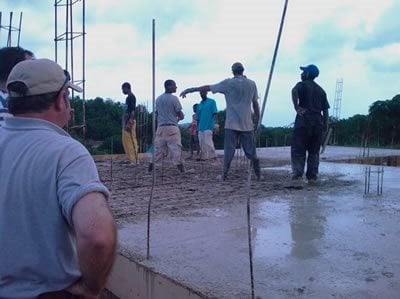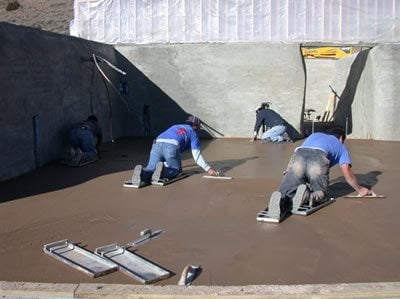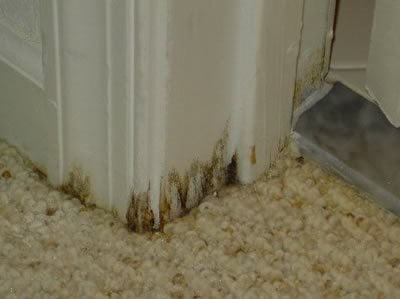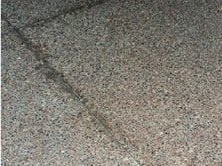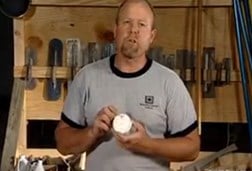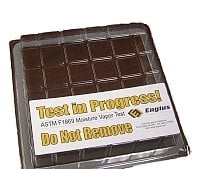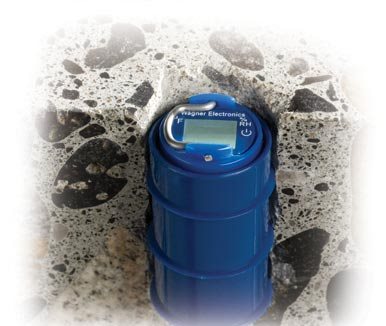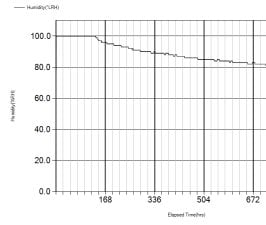- Vapor Barriers for Concrete Slabs
- Concrete Moisture Problems
- Vapor Barrier Installation
- Related Information:
- Avoiding moisture-related problems with concrete sealers: Advice from expert Chris Sullivan
- Reducing bond failures caused by moisture- vapor transmission
- Don't let water vapor delaminate your overlay
- W. R. MEADOWS White Paper - Tips on Choosing Vapor Barriers
- Are concrete floors cold and damp?
- Product Newsletter: Sign up today to receive monthly updates
- Free Vapor Barrier Catalog & Info
Section Sponsor
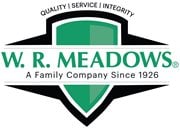
W. R. MEADOWS
Moisture Coming Up Through Concrete
Find out why your concrete floor or slab is wet or sweating and what to do about itExcessive moisture coming through your concrete can cause a variety of problems. Read on for an explanation of the problem and possible solutions.
Why is there Water Vapor in Concrete?
Most people, even many people in the concrete business, think concrete is water tight. After all, we make water tanks and dams out of concrete. But the truth is that although concrete does a good job of containing liquid water-at least when there are no cracks-water vapor moves readily through concrete at a rate that depends on the concrete's porosity and permeability.
Find out where to buy vapor barriers and other problem solving products.
All concrete starts out wet. If there wasn't water in the mix, you couldn't place it and it would never gain strength. At a water-cement ratio of 0.50, there is about 300 pounds of water and 600 pounds of cement in a cubic yard. As the concrete begins to set, some of that water (about half) combines with the portland cement (through hydration) and some rises to the surface as bleed water where it evaporates. The rest is in the pores of the concrete.
After the curing period, the slab begins to dry. At this point there is a lot of liquid water in the concrete pores-in fact, the slab is saturated. This liquid water begins to evaporate from the surface and if no additional water gets into the concrete, within about 90 days for normal-weight, 0.5 w/c concrete, the slab will be dry enough so that most floor coatings won't delaminate.
Water vapor leaves the surface of a concrete slab at a rate that is called the Moisture Vapor Emission Rate (MVER). When you read in a sealer data sheet that the MVER needs to be 3 pounds or 5 pounds, what that means is the number of pounds of water vapor per 1000 square feet per 24 hours. Envision a 31.6 x 31.6 foot section of concrete (1000 square feet) and imagine 3 pounds of water evaporating from the surface each day. Three pounds of water is about three pints ("a pint's a pound the world around"), so that's not much.
But what if the slab is placed on the ground without a vapor barrier? Think about what happens when you dig a hole in moist ground. Long before you get to the water table (liquid water), you will encounter damp soil. That's how the soil beneath your slabs looks-damp. The ground beneath nearly all concrete slabs is damp-in fact, it nearly always has a relative humidity of 100%. That means it is a continuous source of water vapor into the slab and the slab will never dry out-especially if you put a coating on the surface that restricts the movement of water vapor. ACI 302.2R-06, Guide for Concrete Floors that Receive Moisture-Sensitive Flooring Materials, states that "A concrete slab-on-ground without a vapor retarder/barrier directly beneath it may have a final relative humidity profile that does not benefit from any initial drying."
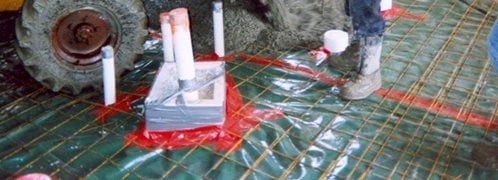 PERMINATOR 15 mil Vapor Barrier
Toughest product on the market with superior puncture resistance
PERMINATOR 15 mil Vapor Barrier
Toughest product on the market with superior puncture resistance
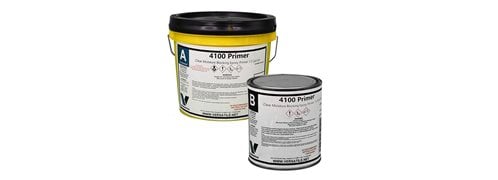 Moisture Blocking Epoxy
4100 clear primer
Moisture Blocking Epoxy
4100 clear primer
What Problems Does Moisture Create?
All natural systems tend towards equilibrium. A hot cup of coffee transfers heat to the air in the room until they are both at the same temperature (this is related to entropy and the second law of thermodynamics). In chemistry, higher concentrations of a chemical move towards areas of lower concentration (known as Le Chatelier's principle). The same is true for areas of higher or lower relative humidity (which is actually a measure of the vapor pressure of water vapor in air). This movement of vapor is called diffusion.
These principles mean that if the relative humidity in the concrete slab is different than the relative humidity of the air above the slab, then moisture is going to try to move in or out of the slab. Without a vapor barrier, the relative humidity in the slab just below the surface can often be 100%. Since the air is seldom that humid, moisture is going to move from the slab into the air and as the surface dries a bit it will draw moisture up from the bottom.
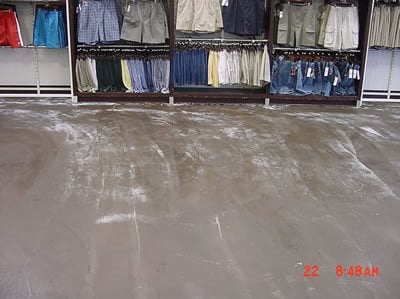
Whitening of sealers is often caused by applying it to a wet surface. QC Construction Products in Madera, CA
So why is that a problem? Water vapor from the floor can make rooms more humid, which can be a concern with new tighter home construction. In extreme cases, when you started with wet concrete or when the ground beneath the slab is very wet, the floor can actually be damp and slick and moisture will condense beneath objects placed on the slab. Wet floors can also promote mold growth.
For decorative concrete there are three potential problems with a lot of moisture coming out of slabs. First, if you stain a slab that has lots of moisture movement, especially stains that use copper salts, you can get blackening or discoloration. Second, as water vapor moves through the slab, it can condense into liquid water and leach calcium hydroxide which then ends up as efflorescence on the slab surface. This can also result in high pH levels at the slab surface.
But the biggest problem for decorative concrete with a lot of moisture moving through a slab is the pressure it exerts at the surface. If there is too much moisture in the concrete, and an impermeable layer is placed over it the moisture migration can delaminate the coating (sealer) or overlay. Sealers that allow some vapor passage can be used, but most topical membrane sealers require a moisture vapor emission rate (MVER) of 3 or 5 pounds/1000 square feet/24 hours.
In commercial applications, when carpet, wood, or vinyl flooring is installed over damp concrete, moisture creates real havoc, since the dampness and high alkalinity will lead to mold, emulsified adhesives, and warped flooring (see Flooring System Failures: How it Happens, from W.R. Meadows). This very expensive problem has led to a lot of research in recent years, and the simple answers that have emerged are to use a low water-cement ratio concrete (0.5 or less) and to install a vapor barrier under slabs on ground.
How Do We Test Moisture Vapor Transmission?
There are a couple of simple tests that tell us a few things about how much vapor is coming out of our floor and a more difficult test that tells us more. The old standby is simply to duct tape an 18-inch square of clear plastic on the surface of the slab (ASTM D 4263). Come back in 16 hours and if there is moisture under the plastic, it's too wet for an overlay or a sealer or anything else that could delaminate. But temperature and dew point can affect this test and a dry sheet test isn't necessarily a sure sign.
A common test that has been used for many years is the calcium chloride test (ASTM F 1869). This test is done with kits that are available from a variety of sources (such as Vaprecision, or Engius). This test indicates how much moisture is coming out of the slab. However, there is no reliable way to calibrate the test and it only indicates what's happening at the surface and at that moment-ambient conditions can change the results and it only tells us the moisture in the top ½ inch of the slab. If an impermeable coating is applied, everything can change. But if you have no choice, you might have to rely on this test.
The best way to test for slab moisture is with relative humidity testing (ASTM F2170). RH probes are embedded into the slab or inserted through small drilled holes. This method indicates the moisture condition throughout the slab. The ideal is to have a slab with an average relative humidity below 75%, although floors as high as 90% are acceptable for some floor coatings. For details on this, talk with the folks at Wagner Electronics or at Engius. Another great source of information is Howard Kanare's book, Concrete Floors and Moisture, available from the Portland Cement Association.
